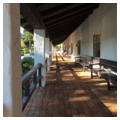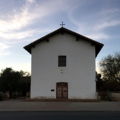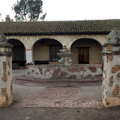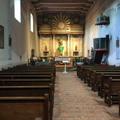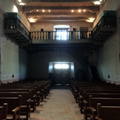Beginning in the mid-eighteenth century and extending into the early nineteenth century, the Spanish crown strategically consolidated its power in its Nueva España colony of Alta California by allowing Catholic priests to establish mission churches. By 1823, twenty-one missions dotted the California coastline from San Diego to Sonoma. Along with the presidio fort and pueblo town, the mission was the third institution that had proven successful as a colonizing method in other Spanish dominions including Mexico and South America. Manned by Franciscan priests, the aim of the missions was to spread Christianity to Indigenous populations, thereby molding obeisant, Europeanized citizens loyal to Spain. The missions’ lasting influence on the California landscape cannot be underestimated: each formed the core of municipalities and metropolises that developed in the nineteenth and twentieth centuries, including San Diego, Los Angeles, and San Francisco.
During his reign 1759–1788, King Charles III perceived a threat to the Spanish hold on Alta California from an increase of Russian fur traders in the north and the British in the east. In 1767, after expelling the Jesuits, Charles directed the Franciscans to direct colonizing efforts in Alta California. Led by Friar Junípero Serra y Ferrer (1713–1784), the Franciscans began a northward expansion of the mission system. Serra oversaw the completion of the first mission, Mission San Diego de Alcalá, at the southern end of the chain in 1769, followed by the Mission San Carlos Borroméo de Carmelo in Monterey, Spain’s northern outpost, in 1770. Before his death, Serra established seven additional missions between these anchors while his successor, Fermin de Francisco de Lasuén de Arasqueta (1736–1803), established another nine missions between 1786 and 1798. Within thirty-five years nineteen missions were established; the last two were added decades later, strung along the coast on El Camino Real, each one-day’s ride (about thirty miles) from the last. The farthest inland, Mission Nuestra Señora de la Soledad, was thirty miles from shore.
Above all, the missions were tools of colonization. Between 1769 and 1834, Franciscan priests baptized 53,600 adult Native Californians who were then forced to build the missions and work for the self-sustaining settlements. Each mission was sited near a reliable water source and outlying agricultural fields supported the colony. While the Church exploited the labor of these neophytes, it also unwittingly killed them by introducing diseases for which they had no natural immunity, such as tuberculosis, diphtheria, and smallpox. In the same mission period, 37,000 Natives were buried in mission cemeteries, 45 percent of their deaths attributed to two plagues of measles in 1806 and 1828.
The missions’ built forms and spatial organization followed a pattern that was repeated with little variance, and yet the chapels—the heart of each mission—were aesthetically differentiated. The missions were often arranged in a quadrangle and enwalled by the rectangular cells that fronted an interior courtyard. The construction of the church, built of local masonry or adobe bricks, took priority while mendicants dwelled in temporary, crude wooden shelters with thatched roofs. Eventually such huts were replaced by low-slung stone or adobe buildings that contained workshops, kitchens, dormitories, storage rooms, stables, barns, and other facilities. Agriculture and ranching were the lifeblood of each isolated colony, and the Native laborers grew and milled barley, maize, wheat; planted and harvested orchards and vineyards; and raised and slaughtered cattle and sheep. The Criolla varietal or Mission grape was first planted at Mission San Juan Capistrano in 1779, the first Californian olive at Mission San Diego de Alcalá in 1777, and the Mission San Gabriel Arcángel preceded California’s signature citrus industry with the first orange orchard, planted in 1804.
The mission system began to slowly unravel in 1821, when Mexico achieved its independence and annexed Alta California. For a decade, the Church held onto its immense land holdings. In 1832, the mission system owned one-sixth of the territory’s land and its control of converts despite a secularization program undertaken by the new Californian government. In 1833, the government passed an act that disbanded the missions, relegating them to parish churches, and divided their properties into land grants. Between 1834 and 1838, these vast land grants were sold to individuals who established ranches. Through this privatization, 15,000 converts still dwelling on former mission lands were dispossessed. Whatever holdings the missionaries may have held onto were lost again in 1850, when California became the Union’s 31st state, and state legislation revoked any convert’s claims or titles. In 1853, Archbishop J.S. Alemany petitioned the state to return ownership of 1,051 acres to the Church, which it was granted along with other ranch lands in Santa Barbara and San Luis Obispo counties. Today, most of the missions are owned and maintained by the Catholic Church, while three are still dedicated to the Franciscan Order. Three missions are owned by the California Department of Parks and Recreation and are open to the public as state historic parks.
In the late nineteenth century, a wave of romanticism for colonial Spanish heritage—specifically for mission architecture as a reflection of such—suffused Californian culture, spurred by Helen Hunt Jackson’s novel Ramona (1884). Early preservation efforts were led by the likes of newspaper magnate William Randolph Hearst and other elites who comprised the Landmarks Club of Southern California, which led the restoration of San Diego de Alcalá, San Fernando, and San Juan Capistrano in the 1920s and 1930s. By 1955, the last mission church had been reconstructed. Although the missions widely vary in architectural integrity, seven missions have been designated National Historic Landmarks and fifteen are listed in the National Register of Historic Places. While many missions are no longer wholly intact and a few are complete replicas, the churches have largely been restored.
References
Baer, Kurt. Architecture of the California Missions. Berkeley: University of California Press, 1958.
Bargellini, Clara, and Pamela Huckins. “Junípero Serra’s Tastes and the Art and Architecture of the California Missions.” In The Worlds of Junípero Serra: Historical Contexts and Cultural Representations. Edited by Steven W. Hackel. Oakland: University of California Press, 2018.
Bolton, Herbert E. “The Mission as a Frontier Institution in the Spanish Colonies.” American Historical Review 23 (October 1917): 42-61.
Crosby, Harry. Antigua California: Mission and Colony on the Peninsular Frontier, 1697-1768. Albuquerque: University of New Mexico Press, 1994.
Hackel, Steven W., ed. The Worlds of Junípero Serra: Historical Contexts and Cultural Representations. Oakland: University of California Press, 2018.
Kimbro, Edna E., Julia G. Costello, and Tewy Ball. The California Missions: History, Art, and Preservation. Los Angeles: Getty Publications, 2009.
Kryder-Reid, Elizabeth. California Mission Landscapes: Race, Memory, and the Politics of Heritage. Minneapolis: University of Minnesota Press, 2016.
Lake, Alison. Colonial Rosary: The Spanish and Indian Missions of California. Athens: Ohio University Press, 2014.
Lowman, Robert P. The Spanish Missions of California. Arroyo Grande, CA: Lowman Publishing Company, 2011.
Maynard, Theodore. The Long Road of Father Serra. New York: Appleton-Century-Crofts, 1954.
Mendoza, Ruben G., and Jennifer Lucido. “Of Earth, Fire, and Faith: Architectural Practice in the Fernandino Missions of Alta California, 1769-1821.” Colonial Latin American Historical Review 2, no. 2 (Spring 2014): 191-237.
Writing Credits
If SAH Archipedia has been useful to you, please consider supporting it.
SAH Archipedia tells the story of the United States through its buildings, landscapes, and cities. This freely available resource empowers the public with authoritative knowledge that deepens their understanding and appreciation of the built environment. But the Society of Architectural Historians, which created SAH Archipedia with University of Virginia Press, needs your support to maintain the high-caliber research, writing, photography, cartography, editing, design, and programming that make SAH Archipedia a trusted online resource available to all who value the history of place, heritage tourism, and learning.




